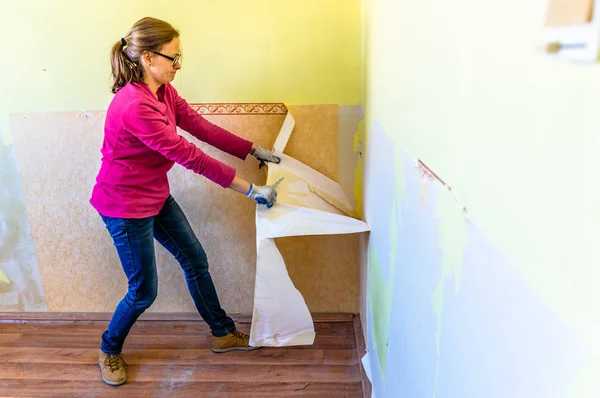Thinking about beginning a home renovation project is both exciting and challenging. If you are even pondering where to start when remodeling a home or exploring how to plan a home remodel, having a clear roadmap is what we require.
So, here, we will provide actionable steps to steer through the entire home renovation process, ensuring your experience is as smooth and rewarding as possible.
Complete the Process To Start Home Renovation

Starting a home renovation project involves careful preparation, budgeting, and execution. Here is a step-by-step breakdown to guide you through:
1. Create Renovation Wishlist
Start by making a renovation wishlist that captures your vision; you need to list every change you want, from new countertops to expanded spaces. Prioritize essential upgrades, like fixing structural issues or modernizing outdated areas. For instance, kitchens and bathrooms often top the list for many homeowners; this foundational step answers the question, Where to start when renovating a home? and sets the tone for your project.
Think about the purpose of the renovation. Are you improving functionality, adding resale value, or simply updating aesthetics? For example, replacing outdated fixtures with energy-efficient models can save on utility costs while modernizing your space. Creating a detailed wishlist keeps you focused and prevents you from overlooking critical aspects of the home renovation plan.
2. Determining Budget
A well-planned budget is the answer to any successful renovation. Begin by assessing your finances to determine how much you can spend. Research your area’s average materials and labor costs to create realistic estimates. Remember to include a 10-20% contingency fund for unexpected expenses. This approach resolves the query, I want to renovate my house where do I start? and ensures you can confidently proceed without financial stress.
Understanding the financial scope can help prevent mid-project surprises, so allocate funds to high-priority areas, such as structural repairs or essential upgrades. Tools like budgeting apps or spreadsheets can help track expenses and ensure you stay within limits; this methodical approach is required for your home renovation planning.
3. Do Proper Research
Research is indispensable in renovation planning; hence, explore platforms like Pinterest or Houzz for design inspiration and contractor reviews. Familiarize yourself with local building codes and permit requirements. Doing homework empowers you to make correct decisions and lays a solid foundation for your home improvement plans.
Moreover, you can visit home improvement stores to compare material options. Speak with experts to understand trends and durability factors; the more informed you are, the better equipped you will be to create a better home remodel plan.
4. Make a Renovation Plan
After creating a wishlist and budget, develop a detailed home renovation plan. Break down the work into sections: plumbing, electrical, painting, and flooring. For those wondering where to start when remodeling a house, prioritize spaces that impact daily life, such as kitchens or bathrooms. A well-structured plan simplifies the home remodeling process and keeps everything organized.
A successful renovation plan should also include milestones and deadlines. If you are handling certain aspects, assign tasks to professionals or DIY components. Factor in holidays or weather conditions that might delay progress; these considerations ensure that your home renovation steps are well-executed and stress-free.
5. Design Process
The design phase transforms ideas into reality. Collaborate with a professional designer to create layouts and 3D renderings of your project. So, if you are considering an open-concept kitchen or a cozy home office, balance aesthetics and functionality. The design process is central to home renovation planning, so your vision remains cohesive and practical.
Consider incorporating sustainable designs, such as energy-efficient windows or solar panels; these eco-friendly choices add value and reduce long-term costs. During the design phase, experiment with colors, materials, and textures to achieve the perfect ambiance for your home.
6. Hire Top-Rated Contractor
Look for experienced professionals with positive reviews and credentials, and choosing the right contractor will work request quotes and detailed contracts that specify timelines, costs, and deliverables. Clear communication about your home renovation service plans with your contractor can prevent misunderstandings and ensure a smoother process by getting professional assistance.
Before signing a contract, verify the contractor’s licensing and insurance. Ask for a portfolio of past projects to assess their quality of work. Trust is vital, so ensure you feel confident in their ability to execute your vision effectively.
7. Set A Timeline
A realistic timeline is a good option for keeping your project on track. Discuss schedules with your contractor and factor in time for permits, material deliveries, and potential delays. A clear timeline aligns everyone involved and helps answer the question.
-
When renovating a house, where do you start?
Setting a timeline also helps you prepare mentally for disruptions in your routine. Share this timeline with all stakeholders to ensure smooth collaboration and deadline adherence.
8. Get Permits
Depending on your renovation scope, you may need permits for plumbing, electrical, or structural changes. Research local requirements and apply early to avoid delays. Securing permits is an essential step in your home renovation plan, as it will ensure compliance with regulations and avoid fines.
Failing to obtain the necessary permits can result in project stoppages or fines. Work closely with your contractor and ensure all paperwork is filed correctly; this step is non-negotiable in your home remodeling process.
9. Plan For Problems
Every renovation has surprises hidden water damage, outdated wiring, or material shortages. Prepare for contingencies and stay flexible; this proactive approach to planning a home remodel will help your project stay on budget and schedule despite unforeseen challenges.
Keep an open line of communication with your contractor to address issues promptly. A backup plan or alternative suppliers can save valuable time and money when unexpected problems arise.
10. Pack Up & Declutter
Clear the renovation area to protect belongings and give workers an unobstructed space. Decluttering safeguards your items and helps you reassess what to keep; this preparatory step is for a smooth home remodeling process, especially in larger projects.
Consider donating or selling items you no longer need. This will make room for new furnishings and lighten the load when setting up your renovated space. Packing efficiently secures your belongings and ensures they remain safe throughout the home renovation process.
Where Will You Stay During Renovation?

Decide on your living arrangements early. Staying home might be feasible for smaller projects, but extensive remodels may require temporary relocation. Planning this minimizes disruptions and keeps the renovation on schedule.
Evaluate options like staying with family or renting a nearby place; this will help balance convenience and cost-effectiveness during your home improvement plans.
Let The Renovation Work Commence
With everything in place, it is time to bring your plans to life. Monitor progress by staying in regular communication with your contractor. Address concerns promptly to keep the project on track. Quality checks must be performed at every phase if you are figuring out how to remodel your home or if your focus is on specific areas.
Do not hesitate to visit the site frequently to ensure the work aligns with your vision. Regular updates from your contractor can help mitigate potential issues and keep everything on schedule.
Get Your Dream Home Renovation From UHS Remodeling
UHS Remodeling, specializes in turning visions into reality. They can create tailored home renovation plans for flawless execution; their team will guide you through every step of the home renovation process. Our expertise guarantees exceptional results when considering how to start renovating a house or looking for unique home improvement plans. Contact us today to begin your journey to a beautifully remodeled home.
Transform Your Home with UHS Remodeling. We will handle the complexities while you enjoy a stress-free renovation experience. Start your dream renovation today!
Conclusion
Embarking on a home renovation project requires meticulous planning, budgeting, and execution. From creating a wishlist to hiring the right contractor, each step ensures a smooth process and a successful outcome.
By following this guide and preparing for challenges, you can transform your vision into reality. Trust experts like UHS Remodeling to make your dream renovation seamless and stress-free.
FAQs
1. Where should I start when planning a home renovation?
Start by creating a wishlist of desired changes and prioritizing essential upgrades. Establish a budget and conduct thorough research on designs, materials, and contractors. This foundational step ensures a focused and efficient renovation process.
2. How can I create a home renovation budget?
Assess your finances, research material, and labor costs, and allocate funds to high-priority areas. Include a 10-20% contingency fund for unexpected expenses to avoid financial stress during the project.
3. Why is hiring a professional contractor important?
Hiring an experienced contractor ensures quality work, adherence to timelines, and compliance with building codes. Verify credentials, reviews, and portfolios to choose a contractor who aligns with your vision.
4. What permits do I need for a home renovation?
Permit requirements vary based on the scope of your renovation. Plumbing, electrical, or structural changes often require permits. Research local regulations and secure necessary approvals early to avoid delays.
5. How do I handle unexpected problems during renovation?
Prepare for hidden issues like water damage or outdated wiring by maintaining a contingency fund. Communicate openly with your contractor and have backup plans to address surprises efficiently and stay on schedule.





